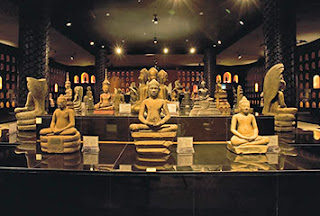Siem Reap
Siem Reap literally means Siam Defeated, referring to the
Khmer sacking of the great Thai city of
Ayutthaya in the 17th century. Until recently, this
French Indochinese town with its Colonial buildings and tree-lined boulevards
was little more than a staging post for visitors on their way to the temples of
Angkor and the Roluos Group. Today, however, it is fast becoming a destination
in its own right, with quality restaurants serving excellent French-influenced
cuisine, upscale boutique hotels, and a new airport. The locals have been quick
to ride the tourist wave with souvenir shops selling silk kramas (scarves), and
tour agencies and massage vendors cropping up.
Angkor National
Museum
968 Charles De
Gaulle Blvd.
Tel (063)-966-601.
8:30am–6:30pm daily.
Opened to the public in 2007, the Angkor National Museum
is housed in a sprawling building with well-manicured lawns. The museum
comprises eight individual galleries, each containing a wealth of ancient
Angkorian artefacts. On arrival, visitors first head to the screening of a
documentary on the
marvels of Angkor entitled Story Behind The Legend. The
next stop is Gallery 1, with its stunning exhibition of 1,000 Buddha images in
wood, stone, and precious jewels.
The subsequent galleries focus exclusively on subjects
such as the pre-Angkorian period, Khmer kings, and Angkor Wat. A mall with a
shopping centre is attached to the museum.
Psar Chaa and
Around
Corner of Pokambor Ave.
dawn to dusk daily.
Once the mainstay of the town’s vendors, today Psar Chaa
today faces serious competition from swanky new malls and supermarkets.
Nevertheless, the market continues to be a popular stop
for both locals and foreign visitors who are drawn to its cool corridors not
only because of the reasonable prices, but also for the sheer variety of goods
on offer. Stalls stock everything from Khmer silk kramas to lacquer ware and
silverware, as well as groceries.
Nearby is the carefully restored old French Quarter and
the atmospheric Pub Street. This lively area, aptly Les Chantiers Écoles Stung
Thmey St. Tel (063)-963-330.
7:30am–5:30pm daily.
www.artisansdangkor.com
A school set up in the early 1990s for under-privileged
children, Les Chantiers Écoles is located down a tiny side street. Here,
children are taught stone carving, lacquer-making, silk painting, and wood
sculpting. Visitors can walk through the workshops with a guide who explains
the stages of each intricate craft; the tour takes about an hour. Artisans
d’Angkor, the school’s shop, is also located in the same complex and sells
products made by the students.
Those keen to see the process of silk farming can head
for the Les Chantiers Écoles silk farm, 10 miles (16 km) northwest of Siem
Reap. The tour takes three hours. Bus rides from Les Chantiers Écoles are
available.
Named for the numerous restaurants and pubs lining its
length, comes alive at night with loud music, apsara dance performances, and
crowds of visitors sauntering up and down the street.
National
Centre for Khmer Ceramics
Charles De
Gaulle Blvd. Tel (063)-963-330. 8am–6pm.
A non-profit, non-government organization, the National
Centre for Khmer Ceramics was established to re-introduce Khmer’s ancient
pottery techniques to the country. The centre also provides valuable job opportunities
to the people of Siem Reap province, which, despite the considerable wealth
accrued
Tonlé Sap Exhibition
16 miles (26 km) N of town centre. 8am–5:30pm daily.
Krousay Thmey, an NGO that supports orphans, has set up
the informative Tonlé Sap Exhibition in the outskirts of Siem Reap. This
exhibition offers an insight into the ecology of the Tonlé Sap, the largest
freshwater lake in Southeast Asia. The lake and its marine-rich waters feed
over 3 million people and visitors to nearby Angkor Wat, is still the poorest
in Cambodia.
Students are taught for free and are encouraged to set up
their own studios on completion of the course.
They learn to work with clay and master the potter’s
wheel, and kilns faithfully modelled on an ancient Khmer design. Guided tours
of the centre are generally given by one of the trainees, and those interested
can also try their hand at the potter’s wheel.
The centre also has a lovely souvenir shop, which sells
some of the finished ceramics made on-site. Shoppers can pick up some good
bargains here. Afterwards, visitors can relax in the center’s charming, shady
tropical gardens.
Cambodian
Cultural Village
6 Airport Rd,
Khum Svay Dang Kum,
Krus
Village. 8am–7pm daily.
www.cambodianculturalvillage.com
Hugely popular with the Cambodians, the Cambodian Cultural
Village is an interesting hour’s diversion for international visitors who want
to learn about Cambodia’s diverse demography, religion, and architecture. There
are Cham (Muslim), Khmer (Buddhist), and Phnong and Kroueng (animist) houses,
as well as floating villages in the complex. There are also miniature replicas
of famous contemporary buildings in Cambodia provide 75 percent of the
country’s annual fish stocks.
The displays, which feature models, nets, illustrations,
and a range of fishing equipment, focus on the varied wildlife of the lake, as
well as its floating villages and the people who live in them. Visitors can
pamper their tired muscles at the end of the day by opting for a traditional
massage at the adjoining NGO, Seeing Hands, which has been set up to help the
blind and wax renderings of national historical figures. A variety of shows,
such as apsara dances, fishing ceremonies, and a lion dance, provide a
brilliant insight into the country’s ancient traditions. This place is worth a
visit, especially for those traveling with children.










